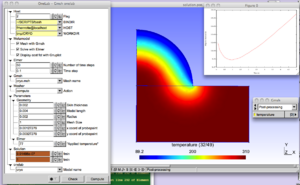Elmer
Elmer is an open source (GPL) computational tool for multi-physics problems. It is developed by CSC in collaboration with Finnish universities, research laboratories and industry.
To be able to test ONELAB models working with Elmer, you need a working installation of the software on your system. As a one-size-fits-all solution, metamodels with Elmer are distributed on a virtual machine, which you need first to install on your system: ONELAB virtual machine.
Contents
Getting started with the Virtual Machine
- Step 1 - Install Virtual Box
- If you don't have a virtualization utility already installed on your system, go to the Oracle VirtualBox website to download a binary package suitable for your host operating system. Follow the documentation to install the software components and to start the VirtualBox Manager.
- Step 2 - Download the Virtual Machine ONELAB_VM
- Virtual Machine
- SHA1 checksum
- Step 3 - Import the Virtual Machine in Virtual Box
- In the VirtualBox Manager, import the downloaded OVA file by following the instructions. A new VM entry - named ONELAB_VM appears in the left panel.
- Step 4 - Start the Virtual Machine
- Start the VM by double clicking its entry in the VirtualBox Manager. Enter "plos" for login and "plos" again for password (without quotes).
- Step 5 -
- Open the Firefox browser of the Virtual Machine, reload this page and proceed from within the Virtual Machine.
CRYO
Download and inflate the archive CRYO.zip in a work directory. Right-click on the icon cryo.ol and open the file with gmsh. Alternatively, start gmsh and click File > Open > cryo.ol from the menu.
The physical background is the cryogenic treatment of warts by application of a cryogenic fluid. The idea is to maximize the destruction of wart tissue cells while minimizing damages to healthy skin tissue. A damage function depending on temperature distribution and exposure time is built to represent this trade-off. The purpose of the modeling is to determine the application time that minimizes the damage function.
Various geometrical and modeling parameters can be interactively modified in the ONELAB window. After execution, a plot of the damage function vs. time is displayed and the computed optimum application time tmin is shown in the ONELAB window in the highlighted box.
BEAM
Download and inflate the archive BEAM.zip in a work directory. Right-click on the icon cryo.ol and open the file with gmsh. Alternatively, start gmsh and click File > Open > cryo.ol from the menu.
This model is the didactical analysis of a clamped beam (static 3D elasticity). The dimensions of the beam and the material parameter can be modified interactively in the ONELAB window, as well as a number of modeling parameters. Diagrams of the internal moments can be generated. Check for this the box Compute MT diagrams, click on Check, and then on Run.
LASER
Download and inflate the archive LASER.zip in a work directory. Right-click on the icon laser.ol and open the file with gmsh. Alternatively, start gmsh and click File > Open > laser.ol from the menu.
The physical background of this model is the laser stimulation of skin in order to measure the density of nociceptive receptors. For a correct interpretation of the experimental data, an accurate knowledge of the temperature distribution in time and across the skin is needed. The metamodel allows selecting various laser types (Gaussian, flat-top) and various stimulus characteristics (imposed flux or controlled temperature). Each simulation generates a graphical result file plot.pdf that is directly interpretable by clinicians.
